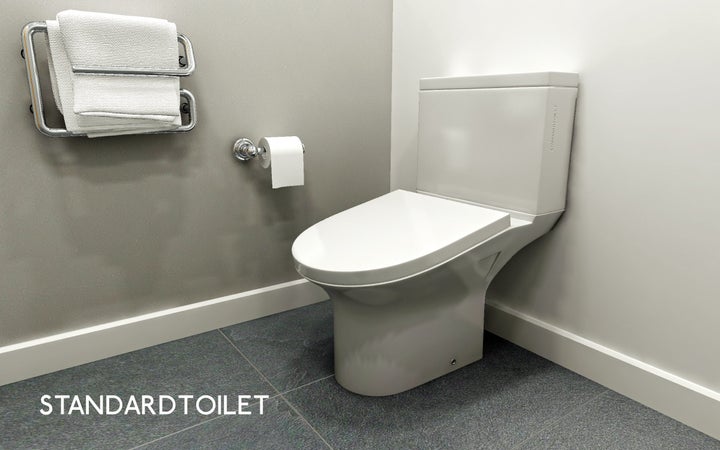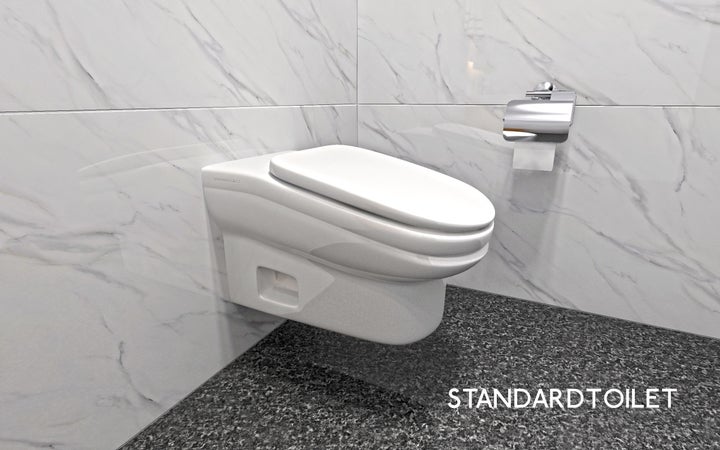
Bosses already monitor employees’ emails, Slack messages and keystrokes to increase productivity at work. Now a British company, StandardToilet, has developed a toilet that discourages long bathroom breaks. The company has filed a patent for a fixture designed to increase employee productivity by making it uncomfortable for anyone to dwell on the toilet seat.
“Current toilet seats provide a horizontal seating surface,” StandardToilet’s website states. “This enables a user to sit relatively comfortably on the toilet.”

And apparently that’s a problem. Sloping forward at an angle of 13 degrees, StandardToilet’s product is designed to make it uncomfortable to spend longer than about five minutes on it without experiencing leg strain, Mahabir Gill, founder of StandardToilet, told Wired UK in an article published Monday.
“Thirteen degrees is not too inconvenient, but you’d soon want to get off the seat quite quickly,” Gil told the magazine. The magazine reported that Gil is in talks with several local councils and service stations to use his product.
Company sees toilet design in terms of employee productivity.
“By using our uniquely designed WC, the time spent on the WC is considerably reduced, easing queuing congestion and benefiting businesses,” StandardToilet’s website claims.
Raymond Martin is the managing director of the British Toilet Association group that endorsed the patent on StandardToilet’s website. Citing overcrowding of public restrooms, Martin said, “We’re endorsing a new design which may help people use the toilets better” because “it keeps everybody moving.”
Jennifer Kaufmann-Buhler, assistant professor of design history at Purdue University in Indiana, said the toilet makes assumptions about the kind of person who will be using it. “It kind of imagines that the process of urinating and defecating are these mechanical aspects of our bodies that always operate the way that they are supposed to. That we all have bowels that move efficiently, that we all pee at the same level, Kaufmann-Buhler said. “Bodies aren’t standard.”
In an email, StandardToilet told HuffPost that the product is not designed to replace toilets for people with disabilities.
Assuming that the product was in compliance with the Americans With Disabilities Act and other countries’ regulations for accessibility, there could still be issues if this toilet were to go mainstream, a workplace disability expert said. Nadine Vogel is the CEO of Springboard Consulting, a business that works with companies on how to serve workers with disabilities. “Is it necessarily useable for all by a universal design point?” Vogel said is the question StandardToilet should be asking themselves to be more inclusive to employees with disabilities. “What is accessible is not always useable,” Vogel said.
Vogel outlined scenarios of workers who may or may not have a documented disability but need longer bathroom breaks. It could be a diabetic worker who needs to take a glucose test while sitting comfortably on a toilet seat, she said. Or it could be someone needing that break for their mental health. “The fact that the concern is extended employee breaks ― well, what about people that have some kind of mental health situation that actually need that kind of longer break?” Vogel said.
Employees already feel pressured to take shorter breaks.
Harvey Molotch, a professor of sociology at New York University and co-editor of “Toilet: Public Restrooms and the Politics of Sharing,” said his immediate reaction to the patent was that it was a “spoof.” I confirmed through the United Kingdom’s Intellectual Property Office that Gil’s “Toilet with an inclined seating surface” patent is real and that the patent filing was published Aug. 14.
In general, Molotch said this toilet monitoring is part of the history of “anxiety that people are ‘misusing’ toilet facilities for things not intended and, indeed, doing things that are sinful: drugs, sex, loafing.”
Kaufmann-Buhler said this product assumes how an employee’s time should be managed. “I do think it’s a very capitalist mentality that people’s physical bodies and its problems and limitations are inconveniences to modern capitalism that want you to be productive whatever the cost,” Kaufmann-Buhler said.
Employees already feel pressure to take shorter bathroom breaks. Seventy-four percent of Amazon warehouse workers avoid using the toilet out of fear of being warned about missing their target numbers, according to a survey of more than 100 employees by worker rights platform Organise.
Office design can add another physical layer to this pressure to be an efficient worker. Since direct surveillance would be “indecent invasion of the most private of our acts,” employers control workers’ toilet habits through equipment, Molotch said. “Instead of a real cop, the cop is built into the machinery itself,” he added.